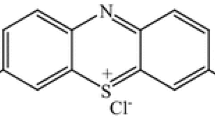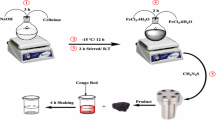Abstract
In the present study, the adsorption removal of anionic (MO) and cationic (MB) dyes with GO/HEMA and GO/HEMA/TiO2 and GO/Fe3O4/HEMA nanocomposites as adsorbents was investigated. Characterization of properties was determined by FTIR, XRD, SEM, TEM, EDX, and zeta potential analysis. Parameters affecting the removal of pollutants including dye concentration (0.7 mg/l), contact time (60 min), and temperature (298 °K) were investigated. Pollutants removal mechanisms were studied with pseudo-first-order, pseudo-second-order kinetic models as well as Freundlich Langmuir isotherms. Pollutant removal for all three composites was confirmed by the Freundlich isotherm (R2 = 0.99) and first-order kinetics (R2 = 0.98).
Graphical abstract
Synthesis of nanocomposite as an adsorbent for dye removal.

















Similar content being viewed by others
References
He C, Shi ZQ, Ma L, Cheng C, Nie CX, Zhou M, Zhao CS (2015) Graphene oxide based heparin-mimicking and hemocompatible polymeric hydrogels for versatile biomedical applications. J Mater Chem B 3:592–602. https://doi.org/10.1039/c4tb01806k
Benkhaya S, M’rabet S, El Harfi A (2020) A review on classifications, recent synthesis and applications of textile dyes. Inorg Chem Commun 115:107891. https://doi.org/10.1016/j.inoche.2020.107891
Panda J, Sahoo JK, Panda PK, Sahu SN, Samal M, Pattanayak SK, Sahu R (2019) Adsorptive behavior of zeolitic imidazolate framework-8 towards anionic dye in aqueous media: combined experimental and molecular docking study. J Mol Liq 278:536–545. https://doi.org/10.1016/j.molliq.2019.01.033
Hasanzadeh M, Simchi A, Far HS (2019) Kinetics and adsorptive study of organic dye removal using water-stable nanoscale metal organic frameworks. Mater Chem Phys 233:267–275. https://doi.org/10.1016/j.matchemphys.2019.05.050
Saliba D, Ammar M, Rammal M, Al-Ghoul M, Hmadeh M (2018) Crystal growth of ZIF-8, ZIF-67, and their mixed-metal derivatives. J Am Chem Soc 140:1812–1823. https://doi.org/10.1021/jacs.7b11589
Benkhaya S, M’rabet S, El Harfi A (2020) Classifications, properties, recent synthesis and applications of azo dyes. Heliyon 6. https://doi.org/10.1016/j.heliyon.2020.e03271
Aksu Z, Çaǧatay ŞŞ (2006) Investigation of biosorption of Gemazol Turquise Blue-G reactive dye by dried Rhizopus arrhizus in batch and continuous systems. Sep Purif Technol 48:24–35. https://doi.org/10.1016/j.seppur.2005.07.017
Al-Degs YS, El-Barghouthi MI, El-Sheikh AH, Walker GM (2008) Effect of solution pH, ionic strength, and temperature on adsorption behavior of reactive dyes on activated carbon. Dye Pigment 77:16–23. https://doi.org/10.1016/j.dyepig.2007.03.001
Wang C, Liu X, Keser Demir N, Chen JP, Li K (2016) Applications of water stable metal-organic frameworks. Chem Soc Rev 45:5107–5134. https://doi.org/10.1039/c6cs00362a
Zhixing Yu, Bai Yu, Wang JH, Li Y (2021) Effects of functional additives on structure and properties of polycarbonate-based composites filled with hybrid chopped carbon fiber/graphene nanoplatelet fillers. ES Energy & Environment 12:66–76
Jain B, Singh AK, Hashmi A et al (2020) Surfactant-assisted cerium oxide and its catalytic activity towards Fenton process for non-degradable dye. Adv Compos Hybrid Mater 3:430–441
Wu JS, Liu CH, Chu KH, Suen SY (2008) Removal of cationic dye methyl violet 2B from water by cation exchange membranes. J Memb Sci 309:239–245. https://doi.org/10.1016/j.memsci.2007.10.035
Lau YY, Wong YS, Teng TT, Morad N, Rafatullah M, Ong SA (2015) Degradation of cationic and anionic dyes in coagulation-flocculation process using bi-functionalized silica hybrid with aluminum-ferric as auxiliary agent. RSC Adv 5:34206–34215. https://doi.org/10.1039/c5ra01346a
Kim IC, Lee KH (2006) Dyeing process wastewater treatment using fouling resistant nanofiltration and reverse osmosis membranes. Desalination 192:246–251
Lin C, Liu B, Pu L et al (2021) Photocatalytic oxidation removal of fluoride ion in wastewater by g-C3N4/TiO2 under simulated visible light. Adv Compos Hybrid Mater 4:339–349
Cheng W, Wang Y, Ge S et al (2021) One-step microwave hydrothermal preparation of Cd/Zr-bimetallic metal–organic frameworks for enhanced photochemical properties. Adv Compos Hybrid Mater 4:150–161
Tavassoli N, Ansari R, Mosayebzadeh Z (2017) Synthesis and application of iron oxide/silica gel nanocomposite for removal of sulfur dyes from aqueous solutions. Arch Hyg Sci 6:214–220. https://doi.org/10.29252/archhygsci.6.2.214
Cao W, Han M, Qin L et al (2019) Synthesis of zeolitic imidazolate framework-67 nanocube wrapped by graphene oxide and its application for supercapacitors. J Solid State Electrochem 23:325–334. https://doi.org/10.1007/s10008-018-4138-1
Yuan B, Li L, Murugadoss V, Vupputuri S, Wang J, Alikhani N, Guo Z (2020) Nanocellulose-based composite materials for wastewater treatment and waste-oil remediation. ES Food & Agroforestry 1:41–52
Liu H, Mao Y (2021) Graphene oxide-based nanomaterials for uranium adsorptive uptake. ES Materials and Manufacturing 13:3–22
Prashant MK, Avinash R, Kachere N, Mandlik T, Rondiya SR, Jadkar SR, Shivaji V, Bhosale, (2021) Graphene oxide assisted synthesis of magnesium oxide nanorods. ES Materials and Manufacturing 12:63–71
Nidamanuri N, Li Y, Li Q, Dong M (2020) Graphene and graphene oxide-based membranes for gas separation. Engineered Science 9:3–16
Cai J, Tian J, Hongbo Gu, Guo Z (2019) Amino carbon nanotube modified reduced graphene oxide aerogel for oil/water separation. ES Materials & Manufacturing 6:68–74
Singh N, Jana S, Singh GP et al (2020) Graphene-supported TiO2: study of promotion of charge carrier in photocatalytic water splitting and methylene blue dye degradation. Adv Compos Hybrid Mater 3:127–140
Cheng C, Liu Z, Li X, Su B, Zhou T, Zhao C (2014) Graphene oxide interpenetrated polymeric composite hydrogels as highly effective adsorbents for water treatment. RSC Adv 4:42346–42357. https://doi.org/10.1039/c4ra07114j
Adsorptive removal of toxic dye using Fe3O4−TSC nanocomposite.pdf, (n.d.)
Vasile E, Pandele AM, Andronescu C, Selaru A, Dinescu S, Costache M, Hanganu A, Raicopol MD, Teodorescu M (2019) Hema-functionalized graphene oxide: a versatile nanofiller for poly(propylene fumarate)-based hybrid materials. Sci Rep 9:1–7. https://doi.org/10.1038/s41598-019-55081-2
Kim SP, Choi HC (2014) Photocatalytic degradation of methylene blue in presence of graphene oxide/TiO2 nanocomposites. Bull Korean Chem Soc 35:2660–2664. https://doi.org/10.5012/bkcs.2014.35.9.2660
Mohammad AKT, Abdulhameed AS, Jawad AH (2019) Box-Behnken design to optimize the synthesis of new crosslinked chitosan-glyoxal/TiO 2 nanocomposite: methyl orange adsorption and mechanism studies. Int J Biol Macromol 129:98–109. https://doi.org/10.1016/j.ijbiomac.2019.02.025
Bhowmik M, Deb K, Debnath A, Saha B (2018) Mixed phase Fe2O3/Mn3O4 magnetic nanocomposite for enhanced adsorption of methyl orange dye: neural network modeling and response surface methodology optimization. Appl Organomet Chem 32:1–17. https://doi.org/10.1002/aoc.4186
Su Z, Zhang M, Lu Z et al (2018) Functionalization of cellulose fiber by in situ growth of zeolitic imidazolate framework-8 (ZIF-8) nanocrystals for preparing a cellulose-based air filter with gas adsorption ability. Cellulose 25:1997–2008. https://doi.org/10.1007/s10570-018-1696-4
Shi H, Li W, Zhong L, Xu C (2014) Methylene blue adsorption from aqueous solution by magnetic cellulose/graphene oxide composite: equilibrium, kinetics, and thermodynamics. Ind Eng Chem Res 53:1108–1118. https://doi.org/10.1021/ie4027154
Safaiee M, Zolfigol MA, Derakhshan-Panah F, Khakyzadeh V, Mohammadi L (2016) Synthesis of nano magnetite Fe3O4 based vanadic acid: a highly efficient and recyclable novel nanocatalyst for the synthesis of 4,4′-(arylmethylene)-bis(3-methyl-1-phenyl-1H-pyrazol-5-ols). Croat Chem Acta 89:317–322. https://doi.org/10.5562/cca2854
Cheng C, Liu Z, Li X, Su B, Zhou T, Zhao C (2014) Graphene oxide interpenetrated polymeric composite hydrogels as highly effective adsorbents for water treatment. RSC Adv 4:42346–42357. https://doi.org/10.1039/c4ra07114j
He A, Lei B, Cheng C, Li S, Ma L, Sun S, Zhao C (2013) Toward safe, efficient and multifunctional 3D blood-contact adsorbents engineered by biopolymers/graphene oxide gels. RSC Adv 3:22120–22129. https://doi.org/10.1039/c3ra44775h
Zhao S, Wang H (2020) An integrated H-type method to measure thermoelectric properties of two-dimensional Materials 9:59–66
Ryu H, Roshan R, Kim MI et al (2017) Cycloaddition of carbon dioxide with propylene oxide using zeolitic imidazolate framework ZIF-23 as a catalyst. Korean J Chem Eng 34:928–934. https://doi.org/10.1007/s11814-016-0339-4
Yang N, Zhu S, Zhang D, Xu S (2008) Synthesis and properties of magnetic Fe3O4-activated carbon nanocomposite particles for dye removal. Mater Lett 62:645–647. https://doi.org/10.1016/j.matlet.2007.06.049
Shi H, Li W, Zhong L, Xu C (2014) Methylene blue adsorption from aqueous solution by magnetic cellulose/graphene oxide composite: Equilibrium, kinetics, and thermodynamics. Ind Eng Chem Res 53 (2014) 1108–1118. https://doi.org/10.1021/ie4027154
Yuan Y, Xu X, Xia J et al (2019) A hybrid material composed of reduced graphene oxide and porous carbon prepared by carbonization of a zeolitic imidazolate framework (type ZIF-8) for voltammetric determination of chloramphenicol. Microchim Acta 186:191. https://doi.org/10.1007/s00604-019-3298-8
Babu MJ, Botsa SM, Rani SJ et al (2020) Enhanced photocatalytic degradation of cationic dyes under visible light irradiation by CuWO4-RGO nanocomposite. Adv Compos Hybrid Mater 3:205–212
Zhao D, Gao X, Wu C, Xie R, Feng S, Chen C (2016) Facile preparation of amino functionalized graphene oxide decorated with Fe 3 O 4 nanoparticles for the adsorption of Cr(VI). Appl Surf Sci 384:1–9. https://doi.org/10.1016/j.apsusc.2016.05.022
Nasrollahzadeh M, Atarod M, Jaleh B, Gandomirouzbahani M (2016) In situ green synthesis of Ag nanoparticles on graphene oxide/TiO2 nanocomposite and their catalytic activity for the reduction of 4-nitrophenol, congo red and methylene blue. Ceram Int 42:8587–8596. https://doi.org/10.1016/j.ceramint.2016.02.088
Xu H, Ding M, Chen W, Li Y, Wang K (2018) Nitrogen–doped GO/TiO2 nanocomposite ultrafiltration membranes for improved photocatalytic performance. Sep Purif Technol 195:70–82. https://doi.org/10.1016/j.seppur.2017.12.003
Gul S, Sohni S, Waqar M, Ahmad F, Norulaini NAN, MOAK (2016) Functionalization of magnetic chitosan with graphene oxide for removal of cationic and anionic dyes from aqueous solution. Carbohydr Polym 152:520–531. https://doi.org/10.1016/j.carbpol.2016.06.045
Paredes A, Acuña SM, Gutiérrez L, Toledo PG (2019) Zeta potential of pyrite particles in concentrated solutions of monovalent seawater electrolytes and amyl xanthate. Minerals 9. https://doi.org/10.3390/min9100584
Wang Y, Liang S, Chen B, Guo F, Yu S, Tang Y (2013) Synergistic removal of Pb(II), Cd(II) and humic acid by Fe3O4@Mesoporous silica-graphene oxide composites. PLoS ONE 8:1–9. https://doi.org/10.1371/journal.pone.0065634
Au PI, Leong YK (2013) Rheological and zeta potential behaviour of kaolin and bentonite composite slurries. Colloids Surfaces A Physicochem Eng Asp 436:530–541. https://doi.org/10.1016/j.colsurfa.2013.06.039
Chen K, He J, Li Y, Cai X, Zhang K, Liu T, Hu Y, Lin D, Kong L, Liu J (2017). Removal of cadmium and lead ions from water by sulfonated magnetic nanoparticle adsorbents. https://doi.org/10.1016/j.jcis.2017.01.082
Shojaei S, Khammarnia S, Shojaei S, Sasani M (2017) Removal of Reactive Red 198 by Nanoparticle zero valent iron in the presence of hydrogen peroxide. J Water Environ Nanotechnol 2:129–135. https://doi.org/10.22090/jwent.2017.02.008
Arora C, Soni S, Sahu S, Mittal J, Kumar P, Bajpai PK (2019) Iron based metal organic framework for efficient removal of methylene blue dye from industrial waste. J Mol Liq 284:343–352. https://doi.org/10.1016/j.molliq.2019.04.012
Pirsaheb M, Hossaini H, Nasseri S et al (2020) Optimization of photocatalytic degradation of methyl orange using immobilized scoria-Ni/TiO2 nanoparticles. J Nanostruct Chem 10:143–159
Ali Baig A, Rathinam V, Ramya V (2021) Facile fabrication of Zn-doped SnO2 nanoparticles for enhanced photocatalytic dye degradation performance under visible light exposure. Adv Compos Hybrid Mater 4:114–126
Rajabi M, Mahanpoor K, Moradi O (2019) Preparation of PMMA/GO and PMMA/GO-Fe 3 O 4 nanocomposites for malachite green dye adsorption: kinetic and thermodynamic studies. Compos Part B Eng 167:544–555. https://doi.org/10.1016/j.compositesb.2019.03.030
Fathi MR, Asfaram A, Farhangi A (2015) Removal of Direct Red 23 from aqueous solution using corn stalks: isotherms, kinetics and thermodynamic studies. Spectrochim Acta - Part A Mol Biomol Spectrosc 135:364–372. https://doi.org/10.1016/j.saa.2014.07.008
Kaur D, Bagga V, Behera N et al (2019) SnSe/SnO2 nanocomposites: novel material for photocatalytic degradation of industrial waste dyes. Adv Compos Hybrid Mater 2:763–776
Isa EDM, Shameli K, Jusoh NWC et al (2021) Rapid photodecolorization of methyl orange and rhodamine B using zinc oxide nanoparticles mediated by pullulan at different calcination conditions. J Nanostruct Chem 11:187–202
örgün N, Özer Ç, Polat K (2019) A new catalyst material from electrospun PVDF-HFP nanofibers by using magnetron-sputter coating for the treatment of dye-polluted waters. Adv Compos Hybrid Mater 2:423–430
Huang KY, Wang CT, Chou WL, Shu CM (2013) Removal of polyvinyl alcohol using photoelectrochemical oxidation processes based on hydrogen peroxide electrogeneration. Int J Photoenergy 2013. https://doi.org/10.1155/2013/841762
Mahvi AH, Dalvand A (2019) Kinetic and equilibrium studies on the adsorption of Direct Red 23 dye from aqueous solution using montmorillonite nanoclay. Water Qual Res J 1–13. https://doi.org/10.2166/wqrj.2019.008
Author information
Authors and Affiliations
Corresponding author
Ethics declarations
Conflict of interest
The authors declare no competing interests.
Additional information
Publisher's Note
Springer Nature remains neutral with regard to jurisdictional claims in published maps and institutional affiliations.
Rights and permissions
About this article
Cite this article
Moradi, O., Madanpisheh, M.A. & Moghaddas, M. Synthesis of GO/HEMA, GO/HEMA/TiO2, and GO/Fe3O4/HEMA as novel nanocomposites and their dye removal ability. Adv Compos Hybrid Mater 4, 1185–1204 (2021). https://doi.org/10.1007/s42114-021-00353-7
Received:
Revised:
Accepted:
Published:
Issue Date:
DOI: https://doi.org/10.1007/s42114-021-00353-7




